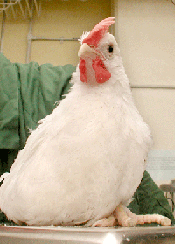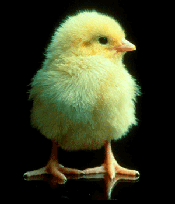Chicken interferon gamma: a new generation therapeutic for the poultry industry
Increased public demands for a ‘cleaner and greener’ environment and stricter controls over food safety and quality have had significant impacts on livestock industries. Antibiotics and chemicals have been used as feed additives in food-production animals that are intensively reared such as poultry, pigs and cattle, in order to prevent disease, promote growth and improve feed efficiency. However the emergence of antibiotic resistant ‘superbugs’ and their possible link to the use of in-feed antibiotics has led to world-wide restrictions in the use of antibiotics in food production animals.
In 1990 CSIRO Animal Health initiated two ambitious research projects aimed at developing new-generation therapeutics for the poultry industry that would reduce reliance on the use of antibiotics and chemicals. This work led to the creation of the spin-off company VectoGen (later acquired by Imugene Ltd) and the commercialisation of a new health product involving the in situ production of the chicken cytokine interferon gamma (ChIFN-γ) that will facilitate the sustainable production of safe, high quality food.
For their contributions to this field John Lowenthal and Mike Johnson were awarded a CSIRO Medal for Research Achievement in 2002.
The poultry industry and problems with in-feed antibiotics and chemicals
There has been a growing concern that the use of antibiotics in animal feed may link to the emergence of drug resistant organisms in livestock which have the potential to be passed on to humans via the food chain. As a result some countries have reacted by banning the use of in-feed antibiotics in food production animals. Consequently, safe natural alternatives are urgently needed.
In response to this scenario, CSIRO Animal Health set out, in 1990, to develop a new generation of therapeutics for the poultry industry that would move away from the reliance on the use of antibiotics and chemicals to control disease in livestock and move towards the use of alternative, naturally produced therapeutics.
The sheer size of the global poultry broiler industry is staggering; 80 billion chickens are hatched worldwide every year. Chicken meat represents approximately 40% of all meat consumed and is a $200 billion per annum global retail market. The Australian industry produces almost 500 million broilers per annum with a retail value of over $2.5 billion and employs approximately 60 000 people. In addition, there are around 10 million layers producing 2.4 billion eggs per year with an annual farm gate value of over $300 million.

Chicken interferon gamma as a possible alternative to antibiotics
The first project, lead by Dr John Lowenthal, focused on assessing the therapeutic potential of a group of proteins called cytokines. Cytokines are naturally produced by the body’s immune system to fight infection caused by bacteria, viruses and parasites. Cytokines protect against disease by controlling the immune response following infection and therefore represent excellent, naturally occurring therapeutics. Interferon gamma (IFN-γ) is a member of a family of cytokines that share the capacity to modulate the immune response and inhibit viral replication and therefore represented a strong candidate as a therapeutic. At the time the issue of whether IFN-γ even existed in avian species was controversial and attempts to isolate the chicken equivalent using mammalian probes was unsuccessful. In 1995, the team patented and subsequently published the sequence of the chicken IFN-γ (ChIFN-γ) and subsequently characterised its biological activity.
The research team performed trials in which young chickens were injected with ChIFN-γ protein. The results showed that treated chickens grew to market weight more quickly and with less feed faster and were generally healthier than untreated chickens. Subsequent research showed that treatment with ChIFN-γ improved the growth rate of chickens by 3-12% over periods of up to 8 weeks. These results clearly indicated the potential use of ChIFN-γ as an effective, naturally occurring growth promoter and a potential replacement for in-feed antibiotics.

Patents based on this work have been granted in the USA, Australia and NZ, and are pending in Europe, Canada and Mexico.
An obstacle to commercial application
At this time, the team faced a significant hurdle: in order for ChIFN-γ to be a commercial product, it must be safely and effectively delivered on a large scale and under commercial conditions. It became apparent that injection of birds with recombinant protein was not a commercially viable process and that an alternative delivery method was needed.
Fowl adenovirus as a delivery vehicle
The Avian Viral Vector Project was initiated in 1988 as a partnership between CSIRO Animal Health and Arthur Websters, an Australian veterinary vaccine manufacturer. It was aimed at developing systems for the commercial scale delivery of vaccines and therapeutics to poultry. The project, initially lead by Dr Mike Sheppard, developed a prototype recombinant fowl adenovirus (FAV) for such applications. In 1993 Dr Sheppard left CSIRO and Dr Mike Johnson took over as Project Leader. In 1996, Mike Johnson developed and refined an FAV-8 vector that was able to deliver and express various antigens in commercial broilers. This vector, for the first time, represented a commercially viable delivery system.
A collaboration between John Lowenthal and Mike Johnson was established in which an FAV-8 vector expressing ChIFN-γ was developed and assessed. Animal trials showed that treatment with FAV-ChIFN-γ enanced the growth rate of chickens by around 10% and improved their ability to fight disease.
Commercialisation: FAV-ChIFN-γ and the formation of the spin-off company VectoGen
The impact of FAV-ChIFN-γ can be seen in the current climate of withdrawal of antibiotic additives from food-production animals. The possible link between antibiotic resistant bacteria in animals and those which might infect humans, makes FAV-ChIFN-γ a valuable and unique product. The intellectual property from FAV and ChIFN-γ including 3 families of granted international patents, was licensed to a spin-off company, VectoGen Limited, which was later acquired by Imugene Limited. This novel product is supported by the poultry industry and has generated international significance as demonstrated by a recent license agreement with Merial, a major international biopharma, which resulted in a $30M deal. The return to CSIRO from this product will be substantial, considering the size of the global broiler market.
This technology is currently being extended to the delivery and expression of other cytokines as well as vaccine antigens. CSIRO predict that this type of strategy can be adopted more widely and produce beneficial results in other livestock animals such as pigs and cattle. These new-generation therapeutics will ultimately assist livestock producers to provide the consumer with food that is safer, of higher quality and produced with lower environmental impact.
Source
- Lowenthal JW, 2009, Personal communication.
